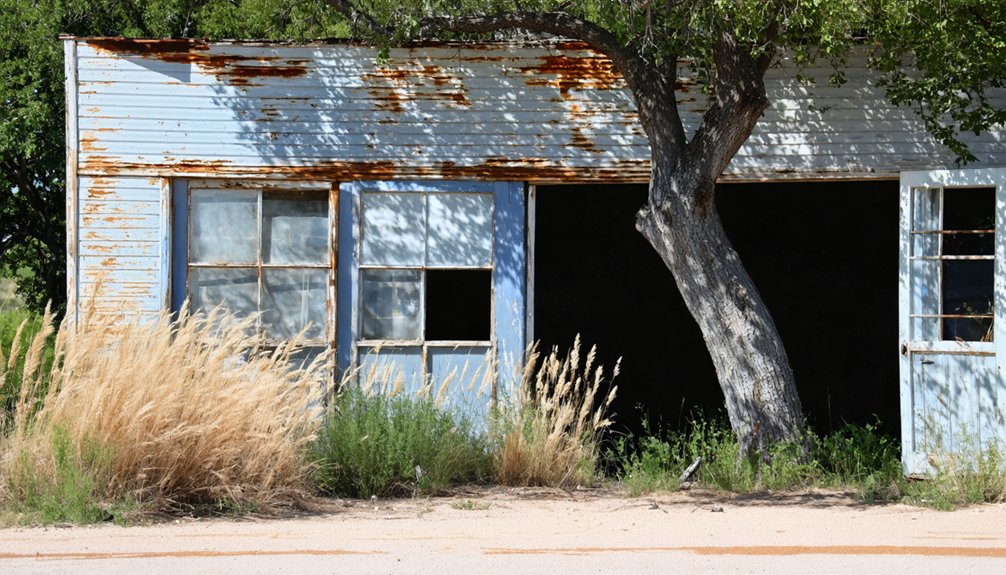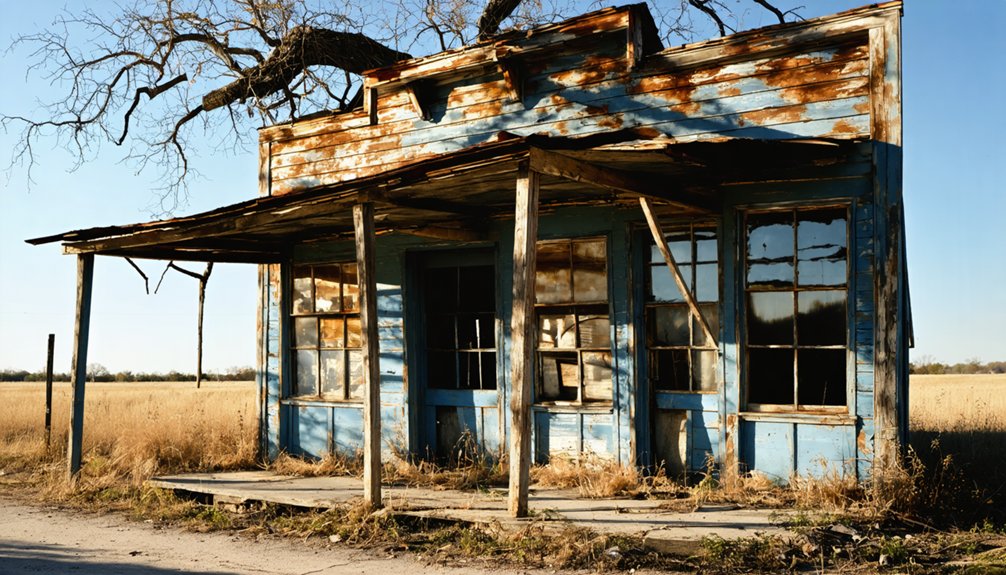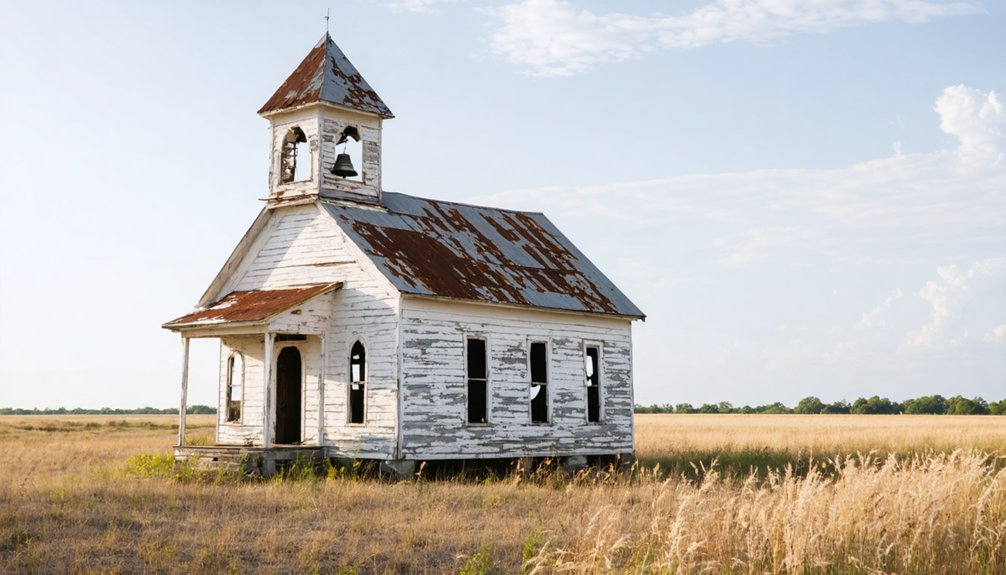You’ll find Graytown, a ghost town founded by Scottish immigrant James Gray, along the San Antonio River in southeast Bexar County, Texas. The town flourished in the late 1800s as an agricultural hub with a peak population of 369 residents in 1900. Railroad rerouting, the boll weevil’s devastation of cotton crops, and the Great Depression led to its abandonment. Today, sandstone ruins, track beds, and building foundations reveal clues about this once-thriving community’s past.
Key Takeaways
- Graytown was established by Scottish immigrant James Gray through marriage to Simona Fernandez Seguín and reached its peak population of 369 in 1900.
- The town’s decline began when railroad rerouting bypassed the settlement, followed by devastating cotton crop losses from boll weevil infestations.
- Economic isolation, Great Depression hardships, and the closure of essential services like the cotton gin led to widespread abandonment.
- Visible ruins today include railroad infrastructure, sandstone blocks, abandoned right-of-ways, and deteriorated building foundations marking the original town layout.
- The site now functions as a ghost town tourist destination, offering opportunities for photography and artifact hunting with historical map guidance.
The Scottish Origins of Graytown
While many Texas settlements emerged from various European migrations, Graytown’s Scottish roots trace directly to James Gray, a Scottish immigrant who established the community through his marriage to Simona Fernandez Seguín.
You’ll find that Gray’s settlement pattern reflected the broader Scottish immigration experience in Texas, where Scots often arrived individually rather than in large groups. This individual migration approach was typical of early Scottish settlers who came to Texas as early as 1825.
Like other settlers from the southern United States, many of the surrounding landowners near Graytown arrived through Republic-era land grants. Unlike many of his countrymen who worked as explorers and mapmakers, Gray focused on developing land he acquired through his marriage to Seguín. His influence grew as the settlement expanded, eventually establishing a post office in 1860 that became a crucial hub for local ranchers.
Railroad Era and Town Development
After stagecoaches and wagons had dominated South Texas transportation for decades, the arrival of railroads in the 1880s transformed Graytown’s regional significance.
You’ll find that the San Antonio & Aransas Pass Railroad’s expansion brought sweeping changes, as the iron horse replaced traditional routes like the San Patricio Trail that once started at Graytown.
While railroad expansion created economic opportunities throughout South Texas, it also sparked significant challenges.
Railroad growth brought both prosperity and problems to South Texas communities as they adapted to the new transportation era.
You’d have witnessed large companies like Southern Pacific gaining control of local lines, leading to monopolistic practices that affected shipping rates.
Today, the old railroad routes and historic sites can be explored at the museum’s weekend operating hours, providing a glimpse into Graytown’s transportation heritage.
The Texas Railroad Commission’s establishment in 1892 attempted to reign in these practices, but Graytown’s role in regional transportation had already begun shifting from an essential stagecoach stop to just another point along the expanding rail network.
Just as Lampasas transformed from a cattle town into a resort destination following the arrival of the Gulf, Colorado and Santa Fe Railway, Graytown experienced its own period of change.
Life in Early Graytown Settlement
Since James Gray established his ranch in the early 1800s, Graytown emerged as a diverse settlement where Anglo settlers, Canary Islanders, and Hispanic families forged a tight-knit community.
You’d find laborers and renters working the land while making their homes near the San Antonio River, essential for ranch operations and daily life. Some families who settled here were escaping Indian attacks from Las Islitas.
Our Lady of Guadalupe Church became the heart of community gatherings, where Sisters of Charity, including Sister Pauline, led religious education through weekly catechism classes and First Communion ceremonies in the 1930s. The population peaked at 369 residents in 1900, marking the height of the community’s growth.
The church’s influence reflected the Spanish requirement for Catholic faith in early land ownership.
With modest housing scattered across the ranch lands and no post office, you’d experience a simple but culturally rich lifestyle shaped by both Hispanic and Anglo-American traditions.
Agricultural Heritage and Economic Base
As Graytown’s economy took shape in the early 20th century, you’d find its lifeblood flowing through fields of corn and cotton, supported by a network of family farms and small-scale ranching operations.
Railroad connections initially promised agricultural sustainability, letting farmers ship their crops to distant markets, but Graytown’s reduced rail access eventually hindered its growth compared to neighboring towns.
You’ll notice how farming techniques evolved through community fairs and seasonal gatherings, where families shared knowledge and traded resources. Like many of the 511 ghost towns scattered across Texas, Graytown’s story is one of hope and eventual decline.
Yet market pressures, including volatile cotton prices and ongoing droughts, challenged local farmers’ independence.
While most of Graytown’s original farmhouses now stand empty, their weathered frames and nearby cemetery markers tell the story of determined farming families who once called this Texas soil home.
The town’s decline mirrors modern rural Texas, where rural hospital closures have accelerated the exodus of farming communities.
The Path to Abandonment
If you’d traveled through Graytown in its early years, you’d have found a bustling agricultural community positioned strategically along crucial railroad lines that served as lifelines for local commerce and transport.
As rail companies rerouted major lines and upgraded from steam engines in the early 20th century, Graytown’s brick water tower and rail facilities became obsolete, triggering an exodus of residents seeking opportunities elsewhere. The decline mirrors the pattern seen in many ghost towns in Texas, where railroad rerouting often spelled doom for once-thriving communities. Similar to Independence’s fate when it rejected the Santa Fe Railroad, the town’s inability to adapt to changing transportation needs hastened its downfall.
The town’s agricultural economy, unable to diversify beyond farming, couldn’t sustain its remaining population through the Great Depression, leading to a final wave of abandonment as essential services and businesses shuttered.
Railroad Development Impact
When railroads expanded across Texas in the post-Civil War era, they dramatically reshaped the region’s economic landscape, determining which towns would thrive and which would fade into obscurity.
For Graytown, the arrival of railroad monopolies like Southern Pacific proved devastating, as major rail routes bypassed the settlement, leading to its economic isolation and eventual abandonment.
- Railroad companies controlled the lifelines of commerce and passenger travel
- Southern Pacific’s route selections often meant life or death for small towns
- Towns without rail connections lost their competitive edge in regional trade
- Stage stops and wagon routes became obsolete as rail transport dominated
- Communities bypassed by railroads faced rapid population decline and business losses
Economic Shifts Emptied Town
Railroad isolation marked only the beginning of Graytown’s decline, with broader economic shifts delivering the final blow to this once-promising Texas settlement.
You’ll find that Graytown’s story mirrors many Texas towns that couldn’t adapt to rapid economic changes of the early 20th century. When the boll weevil devastated local cotton crops, farmers lost their primary source of income, and the town’s cotton gin shut down, eliminating essential jobs.
Social upheavals followed as young workers left for urban opportunities, while those who stayed faced dwindling services and commerce. Without transportation connections to larger markets, businesses couldn’t attract new investment or diversify beyond agriculture.
The Great Depression accelerated this exodus, and by the time highways bypassed the area after World War II, Graytown’s fate was sealed.
Population Decline Timeline
Though historical records lack precise population figures, Graytown’s decline followed a distinct pattern typical of rural Texas communities in the early 1900s.
You’ll see that population migration started gradually as agricultural mechanization reduced labor needs, then accelerated during mid-century rural depopulation trends.
- Early residents dispersed rather than concentrating in a town center, limiting peak population
- Post-WWII economic shifts drew younger generations to urban opportunities
- Lack of railroads or major industries made it hard to retain residents
- By late 1900s, only scattered homesteads remained as infrastructure crumbled
- Early 2000s saw the final conversion to “ghost town” status with just a handful of residents
The area’s transformation from farming community to abandoned settlement mirrors countless other Texas towns that couldn’t survive economic centralization and urbanization.
Remnants and Ruins Today

When you visit Graytown today, you’ll find the most prominent remaining structures are deteriorated foundations that outline where buildings once stood.
The scattered stone and concrete bases provide a rough footprint of the town’s original layout, with partial walls still defining the boundaries of former homes and businesses.
These architectural remnants, though weathered by time and Texas elements, offer valuable clues about the settlement’s size and organization during its brief period of prosperity.
Visible Railroad Structures
The visible ruins of Graytown’s railroad infrastructure paint a compelling picture of its transportation history.
You’ll discover sandstone blocks from former railroad buildings scattered across the landscape, while abandoned right-of-ways cut through the terrain as silent witnesses to the town’s bustling past.
Railroad remnants and structural decay tell the story of a once-thriving transportation hub, now marked by weathered foundations and deteriorating stonework.
- Original track beds revealed by linear clearings and disturbed soil patterns
- Historic sandstone blocks showing quarrying marks from railroad construction
- Partially preserved tunnel ruins in the nearby Hill Country
- Wooden posts with rusted metal fixtures marking utility lines
- Parallel fence lines delineating former railroad property boundaries
Building Foundations Still Standing
Scattered across Graytown’s abandoned landscape, native stone and early concrete foundations offer silent testimony to the town’s architectural heritage.
You’ll find rectangular and square outlines marking where homes, stores, and civic buildings once stood, their foundation craftsmanship revealing pioneer construction techniques through stone bonding and early mortar mixtures.
Standing chimneys serve as dramatic vertical markers near these foundations, while concrete slabs hint at former floors and porches.
The architectural significance of larger commercial foundations suggests the locations of general stores and public buildings, some with surviving basement areas.
You can still spot the remnants of multiple fireplaces within residential ruins, along with outdoor ovens and reinforced chimney bases that tell stories of both domestic life and industrial activities in this Texas ghost town.
Tales From Former Residents
Former residents of Graytown paint a vivid picture of frontier life through their collected oral histories and personal accounts. Their community stories reveal the daily rhythms of farming and ranching, while resident memories highlight both the challenges and triumphs of building a life on the Texas frontier.
You’ll find tales of resilience as families faced isolation and limited infrastructure, balanced by warm recollections of seasonal gatherings that strengthened community bonds.
- Hard-working farmers and ranchers shaped the town’s economic backbone
- General stores and schools served as vibrant social hubs
- Seasonal events fostered deep community connections
- Railway service loss marked the beginning of decline
- Families gradually relocated as opportunities dwindled
These personal narratives preserve Graytown’s legacy, documenting how this once-thriving community adapted to changing times before ultimately succumbing to economic pressures and outmigration.
Ghost Town Tourism and Exploration

While former residents’ memories keep Graytown’s history alive, modern-day visitors now explore its abandoned remains as part of Texas’s thriving ghost town tourism scene.
You’ll find plenty of opportunities for ghost town exploration here, from photographing the iconic brick water tower to metal detecting near old building foundations along the Patapsco river tracks.
Current tourism trends show Texas leading the nation with over 500 ghost towns, and Graytown offers the authentic experience you’re seeking.
With hundreds of ghost towns dotting Texas, Graytown stands out as one of the most evocative and genuine destinations.
Bring your camera to capture decaying structures and abandoned power lines, or use historical maps to hunt for artifacts. You can even combine your visit with trips to nearby Ilchester and Ellicott City.
Just remember to research and prepare, as there’s limited tourism infrastructure – you’ll need to be self-sufficient for a safe adventure.
Preserving Graytown’s Legacy
Thanks to dedicated preservation efforts, Graytown’s legacy endures through multiple archival and structural conservation initiatives. Local historical societies, partnering with the Texas Ghost Town Newspaper Collection, have digitized essential records and personal accounts.
Community engagement plays a crucial role in funding preservation through heritage festivals and volunteer work, while historical preservation focuses on protecting key landmarks that tell Graytown’s story.
- Join guided interpretive tours led by local historians who’ll share authentic stories of Graytown’s past
- Support preservation by attending Victorian-themed fundraising events that celebrate the town’s heritage
- Explore digital archives containing newspapers, photographs, and oral histories
- Visit carefully preserved industrial monuments that showcase Graytown’s economic importance
- Participate in educational programs designed to connect younger generations with local history
Frequently Asked Questions
Are There Any Reported Ghost Sightings or Paranormal Activity in Graytown?
You won’t find documented ghost encounters or haunted locations in Graytown’s public records. While East Texas has many paranormal hotspots, no credible investigations or official sightings exist for this area.
What Natural Disasters or Extreme Weather Events Has Graytown Experienced?
Like a parched field yearning for rain, you’ll find Graytown weathered droughts near the Guadalupe River, faced severe storms typical of Tornado Alley, and likely endured regional flooding common to East Texas settlements.
Was Graytown Ever Involved in Any Significant Texas Historical Conflicts?
You’ll find that while Graytown’s founder fought in the Texas Revolution, the town itself wasn’t directly involved in major Texas conflicts, though its location near San Antonio placed it amid historical significance.
Which Indigenous Tribes Originally Inhabited the Area Before Graytown’s Establishment?
You’ll find the original stewards of this land were Native American tribes including the Coahuiltecan peoples, Lipan Apache, and Tonkawa, who freely roamed these hunting grounds near the San Antonio River.
Did Any Notable Outlaws or Lawmen Have Connections to Graytown?
You won’t find any documented outlaw legends or lawman stories specifically tied to Graytown. While it had a sheriff’s office, historical records don’t reveal any notorious figures operating there.
References
- https://www.county.org/county-magazine-articles/summer-2025/ghost-towns
- https://texashighways.com/travel-news/four-texas-ghost-towns/
- https://pastmaps.com/explore/us/texas/wilson-county/graytown/metal-detecting
- https://en.wikipedia.org/wiki/List_of_ghost_towns_in_Texas
- https://cedarbayoumarina.com/four-ghost-towns-under-lake-texoma/
- https://www.youtube.com/watch?v=DXIh_Z6fNms
- https://www.tshaonline.org/handbook/entries/graytown-tx
- https://texashistory.unt.edu/explore/collections/TGTN/
- https://scottishsociety-sa.org/wp-content/uploads/2019/06/Scots.who_.settled.in_.Texas_.pdf
- https://www.tshaonline.org/handbook/entries/scots



